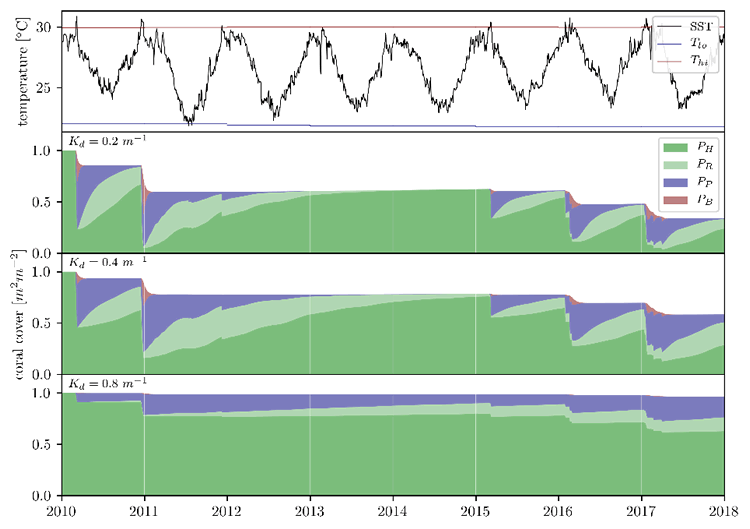G.G. Hendrickx1,2*, J.T. Dijkstra2, P.M.J. Herman1,2, A.P. Luijendijk1,2, J.D. Pietrzak1
1 Civil Engineering, TU Delft, 2 Deltares, *
Introduction
The increasing pressure on Earth's ecosystems due to climate change becomes more and more evident. These pressures are especially visible at coral reefs. Therefore, a good understanding of the biophysical mechanisms controlling these ecosystems is needed, so that accurate predictions of their survival can be made. Such an understanding is also needed to develop efficient recovery and protection programs vital to the maintenance of these ecosystems.
Methods
Because the research on marine ecosystems is relatively young – in comparison with terrestrial ecosystems – and the phenomenon of coral bleaching is yet to be fully understood, there is no comprehensive framework in which the complex interactions between corals and their environment are combined. In this study, a biophysical model is developed in which four environmental factors are included in a feedback loop with the coral's biology: (1) light; (2) hydrodynamics; (3) temperature; and (4) acidity. Literature from multiple disciplines is combined to find the interdependencies between the corals and their environment. These relations include coral growth, coral bleaching, storm damage, and recruitment/recolonization of corals. For the connection with the hydrodynamics, a coupling is made between the biological model developed here and Delft3D-FM.
Results
The composed biophysical model is a big leap forward in understanding the world of coral reefs, as it is the first construction of a model framework including four environmental factors in which the hydrodynamics are included in the feedback loop. Furthermore, it creates the ability to assess recovery and protection programs based on the four aforementioned environmental factors; e.g. the susceptibility of coral bleaching can be reduced by increasing the attenuation of light through the water column (see Fig. 1). Because more environmental factors have a role to play in the coral dynamics, the framework is constructed such that these can be added relatively easily.
Lastly, the model gives insight in the key factors determining the coral survivability. Moreover, focal points are highlighted identifying to which the limited resources and time should be granted.
Figure 1 The effects of the light-attenuation coefficient on the bleaching of corals. Top panel shows the SST time-series and the bottom three panels show the population dynamics in which PH is the healthy population; PR the recovering population; PP the pale population; and PB the bleached population. The white color is the dead population that died due to bleaching. Population covers are given as percentage cover. In the upper left corner of these panels, the light-attenuation coefficient is given.
I. Surname1*, F.N. Another-Surname2 , Y. Next-Surname2
1 University Name, Country; 2 Organization Name, Country
* Corresponding author: mail.name@organization.org


